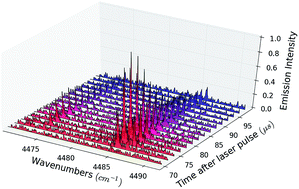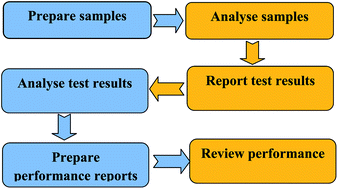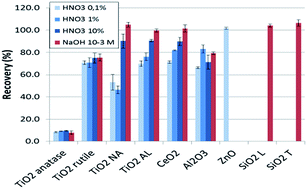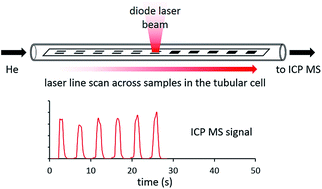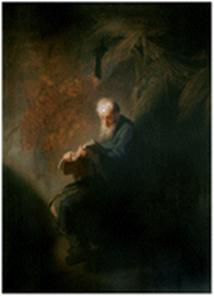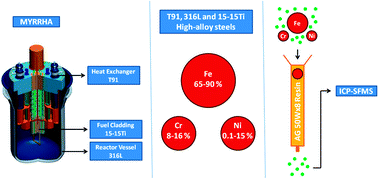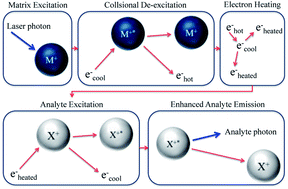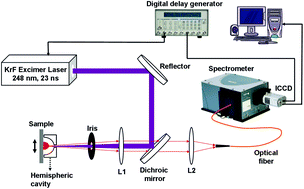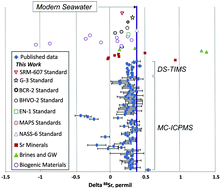Take a look at our recent HOT JAAS articles, these are now free to access for the next few weeks!
Speciation Analysis of Antimony in Water Samples via Combined Nano-Sized TiO2 Colloid Preconcentration and AFS Analysis
Xingwen Wang, Xuankun Li, Xu Zhanga and Shahua Qian
J. Anal. At. Spectrom., 2014, 29, 1944-1948
DOI: 10.1039/C4JA00147H
Laser ablation of an indium target: time-resolved Fourier-transform infrared spectra of In I in the 700–7700 cm−1 range
S. Civiš, P. Kubelík, M. Ferus, V. E. Chernov, E. M. Zanozina and L. Juha
J. Anal. At. Spectrom., 2014, Advance Article
DOI: 10.1039/C4JA00123K
Laser-Ablation Sampling for Inductively Coupled Plasma Distance-of-Flight Mass Spectrometry
Alexander Gundlach-Graham, Elise A. Dennis, Steven J. Ray, Christie G. Enke, Charles J. Barinaga, David W. Koppenaal and Gary M. Hieftje
J. Anal. At. Spectrom., 2015, Advance Article
DOI: 10.1039/C4JA00231H
Characterization of laser ablation sample introduction plasma plumes in fs-LA-ICP-MS
N. L. LaHaye, S. S. Harilal, P. K. Diwakar and A. Hassanein
J. Anal. At. Spectrom., 2014, Advance Article
DOI: 10.1039/C4JA00200H
Determination of Total Uranium and Uranium Isotope Ratios in Human Urine by ICP-MS: Results of an Interlaboratory Study
John G. Arnason, Christine N. Pellegri and Patrick J. Parsons
J. Anal. At. Spectrom., 2015, Advance Article
DOI: 10.1039/C4JA00235K
Traceable Assigned Values in External Quality Assessment Schemes Compared to Those Obtained by Alternative Procedure: A Case Study for Cu, Se and Zn in Serum
Marina Patriarca, Cas Weykamp, Josiane Arnaud, Robert L. Jones, Patrick J. Parsons and Andrew Taylor
J. Anal. At. Spectrom., 2014, Advance Article
DOI: 10.1039/C4JA00260A
Oxygen-18 stable isotope of exhaled breath CO2 as a non-invasive marker of Helicobacter pylori infection
Abhijit Maity, Suman Som, Chiranjit Ghosh, Gourab Dutta Banik, Sunil B. Daschakraborty, Shibendu Ghosh, Sujit Chaudhuri and Manik Pradhan
J. Anal. At. Spectrom., 2014, Advance Article
DOI: 10.1039/C4JA00280F
Development of a fast laser ablation-inductively coupled plasma-mass spectrometry cell for sub-µm scanning of layered materials
Stijn J. M. Van Malderen, Johannes T. van Elteren and Frank Vanhaecke
J. Anal. At. Spectrom., 2015, Advance Article
DOI: 10.1039/C4JA00137K
High-precision measurements of tungsten stable isotopes and application to Earth Sciences
Thomas Breton and Ghylaine Quitté
J. Anal. At. Spectrom., 2014, Advance Article
DOI: 10.1039/C4JA00184B
Elemental recoveries for metal oxide nanoparticles analysed by direct injection ICP-MS: influence of particle size, agglomeration state and sample matrix
Sylvie Motellier, Arnaud Guiot, Samuel Legros and Brice Fiorentino
J. Anal. At. Spectrom., 2014, Advance Article
DOI: 10.1039/C4JA00213J
Exploration of a 3D Nano-channel Porous Membrane Material Combined with Laser-induced Breakdown Spectrometry for Fast and Sensitive Heavy Metal Detection of Solution Samples
Qi Shi, Guanghui Niu, Qingyu Lin, Xu Wang, Jie Wang, Fang Bian and Yixiang Duan
J. Anal. At. Spectrom., 2014, Advance Article
DOI: 10.1039/C4JA00220B
Direct element analysis of honeys by atmospheric pressure glow discharge generated in contact with flowing liquid cathode
Krzysztof Greda, Piotr Jamroz, Anna Dzimitrowicz and Pawel Pohl
J. Anal. At. Spectrom., 2015, Advance Article
DOI: 10.1039/C4JA00261J
Excitation of higher levels of singly charged copper ions in argon and neon glow discharges
Zdeněk Weiss, Edward B. M. Steers, Juliet C. Pickering, Volker Hoffmann and Sohail Mushtaq
J. Anal. At. Spectrom., 2014, Advance Article
DOI: 10.1039/C4JA00309H


